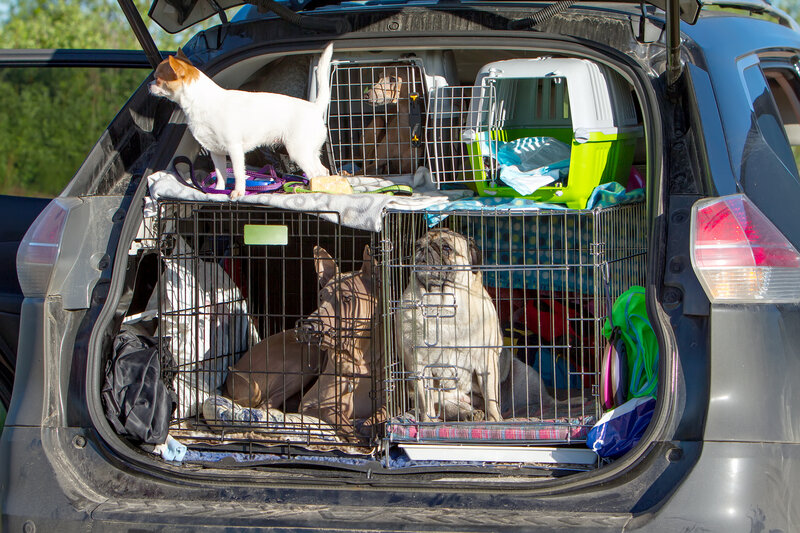In the face of emergencies, ensuring the safety of our furry friends becomes a top priority for pet owners. Whether it’s a natural disaster or an unforeseen event, having a plan in place for the emergency evacuation of pets can make all the difference. This article dives into essential tips and preparations that can safeguard your pets during critical times.
From creating a pet emergency kit to practicing evacuation drills, we cover the key steps to ensure a smooth and stress-free evacuation process. Additionally, we explore the importance of pet-friendly shelters and how to keep your pets calm and comfortable throughout the ordeal. Whether you’re a seasoned pet owner or new to the world of pet care, these insights will equip you with the knowledge and tools needed to protect your beloved companions in times of crisis.
Essential Tips for Evacuation of Pets
When faced with an emergency that necessitates evacuation, the safety and well-being of pets is a paramount concern for their owners. To ensure a smooth and efficient process, here are essential tips for the evacuation of pets:
- Preparation is Key: Ahead of any crisis, compile an easily accessible pet emergency kit. This should include necessities such as food, water, medications, veterinary records, a first aid kit, and daily supplies sufficient for at least a week.
- Identification: It’s crucial that pets have proper identification. Equip them with a collar featuring ID tags and ensure they have a microchip with current contact details. This dual approach maximizes the chances of being reunited with your pet should you get separated.
- Secure Carriers and Leashes: Prepare a sturdy and comfortable carrier for each pet, one that allows them to move freely inside. Familiarize your pets with their carriers to minimize stress. Always use leashes for dogs when evacuating to maintain control and safety.
- Plan Your Destination: Identify in advance where you and your pets will go. Since not all emergency shelters accommodate pets, pinpoint pet-friendly options ahead of time.
- Practice Evacuation Drills: Familiarize your pets with evacuation procedures by conducting regular drills. This helps them get used to entering and traveling in their carriers, reducing both evacuation times and stress.
- Stay Informed: Keep up with local news and weather updates, especially during disaster-prone seasons, to know the optimal time to evacuate.
- Communication: Make sure neighbors, friends, and family are aware of your evacuation plans. If an emergency occurs when you’re not home, having someone available to evacuate your pets is essential.
- Calmness and Comfort: Maintain a calm demeanor to help soothe your pets during evacuation. Surrounding them with familiar items like blankets or toys can also promote comfort.
By incorporating these tips into your emergency preparedness strategy, you can ensure a more organized and less stressful evacuation experience for you and your pets. Emphasizing preparation, identification, and practice are key to safeguarding your pets’ safety and well-being during emergencies.
Why Have a Pet Emergency Plan?
Having a pet emergency plan is critical for the safety and well-being of pets during unforeseen emergencies. This plan equips pet owners with the knowledge and tools needed for prompt and effective action, significantly reducing panic and confusion in critical moments. Key elements of a comprehensive plan include:
- Identifying Safe Havens: Knowing in advance where you can take your pets, such as pet-friendly shelters or hotels, ensures they have a safe place during emergencies.
- Assembling a Pet Emergency Kit: Having a kit with essentials like food, water, medications, and identification can make a significant difference in the well-being of your pets during a crisis.
- Ensuring Easy Identification: Outfitting pets with ID tags and microchips makes it much easier to reunite with them if you get separated.
- Practicing Evacuation Procedures: Familiarizing your pets with their carriers and practicing evacuation drills can greatly reduce stress and the risk of injury.
Ultimately, a pet emergency plan is about proactively safeguarding the lives of pets by preparing for any situation. It aligns with the overarching goal of providing thorough care and protection for our beloved animal companions in times of crisis.
What to Include in a Pet Emergency Kit?
A well-prepared pet emergency kit is vital for the safety and well-being of your pets during emergencies. It should encompass:
- Food and Water: Include enough for at least three days. This ensures your pet stays hydrated and nourished if you’re unable to access your usual supplies.
- Medications and Medical Records: Keep an up-to-date record of vaccinations and any medications your pet needs. This information is crucial for emergency care providers.
- Leashes, Harnesses, and Carriers: These are essential for safely transporting your pet. Ensure carriers are comfortable and secure, to reduce stress during transport.
- Current Photos and Detailed Descriptions: If your pet gets lost, having recent photos and a detailed description can significantly aid in their recovery.
- Pet First-Aid Supplies and a Guidebook: Equip yourself to handle minor injuries or illnesses with basic first-aid supplies and knowledge.
- Contact Information: Have a list of your veterinarian’s contact details and nearby animal shelters. This can be invaluable if you need assistance or if your pet is found by someone else.
Preparing this kit allows pet owners to act swiftly and efficiently, minimizing stress and maximizing the chances of keeping their pets safe during emergencies.
Food and Water for at Least Three Days
Ensure your pet emergency kit includes a three-day supply of food and water. This is crucial for sustaining your pet’s health in case of disruptions.
Medications and Medical Records, Including Vaccination History
Pack any medications your pet requires, along with their medical records and vaccination history. This documentation is essential for receiving emergency care.
Leashes, Harnesses, and Carriers That Are Secure and Comfortable
Secure and comfortable transport options, such as leashes, harnesses, and carriers, are vital for safely evacuating your pets.
Current Photos and Detailed Descriptions of Your Pets
Maintain current photos and detailed descriptions of your pets in the kit. These are invaluable for identification purposes if your pet becomes lost.
Pet First-Aid Supplies and a Guidebook
Include a basic pet first-aid kit and a guidebook to manage minor injuries and health concerns until you can access professional veterinary care.
Contact Information for Veterinarians and Nearby Animal Shelters
Having the contact information for your veterinarian and local animal shelters can offer crucial support and resources during emergencies.
Identifying Pet-Friendly Shelters
Identifying pet-friendly shelters before an emergency arises is crucial for the well-being of your pets. This preparation ensures that you have a predetermined safe place for your animals, reducing stress and confusion during critical times. Effective strategies include:
- Researching local shelters and hotels that welcome pets, providing a secure environment for them in times of need.
- Utilizing online resources that compile lists of pet-friendly accommodations, offering a valuable tool for planning your evacuation route.
By securing this information well in advance, pet owners can facilitate a smoother and more efficient evacuation process, ensuring the safety and comfort of their pets during emergencies.
| Online Resource | Description | URL |
|---|---|---|
| BringFido | A comprehensive guide to pet-friendly hotels and accommodations worldwide. | https://www.bringfido.com |
| PetFriendlyTravel | Specializes in listing pet-friendly vacation rentals, hotels, and lodging options. | https://www.petfriendlytravel.com |
| GoPetFriendly | Offers a user-friendly platform to find pet-friendly hotels, campgrounds, and RV parks. | https://www.gopetfriendly.com |
| PetsWelcome | Features a wide range of pet-friendly lodging options, including unique stays like B&Bs. | https://www.petswelcome.com |
| AAA PetBook | A travel guide for AAA members that includes pet-friendly accommodations across the U.S. and Canada. | https://www.aaa.com/petbook |
Research Local Shelters and Hotels in Advance
Before any emergency unfolds, it’s crucial to research and pinpoint local shelters and hotels that accommodate pets. This proactive step ensures you have a curated list of safe havens, easing the evacuation process for you and your pets.
Use Online Resources That List Pet-Friendly Accommodations
Take advantage of online resources specifically designed to catalog pet-friendly accommodations. These platforms provide detailed insights into various options, simplifying the task of planning a pet-inclusive evacuation route.
Steps During an Evacuation Notice
During an evacuation notice, taking swift and organized actions is key to ensuring the safety of both pets and their owners. The following steps are essential:
- Keep Pets on Leashes or in Secure Carriers: To prevent pets from getting lost or injured, it’s crucial to keep them on leashes or within secure carriers. Opt for carriers that are specifically designed for emergency situations, ensuring they are sturdy, well-ventilated, and large enough for your pet to stand, turn around, and lie down comfortably. For leashes, consider a durable, reflective leash for dogs to enhance visibility in chaotic environments.
- Ensure All Pets Wear ID Tags with Up-to-Date Information: Having current contact information on your pet’s ID tags can greatly increase the chances of reunion if you become separated. Additionally, consider adding a temporary tag with the address and contact information of your evacuation destination if you are going to a specific known location.
- Follow the Advice of Local Authorities for Safe Evacuation Routes: Adhering to the guidance of local authorities ensures that you’re taking the safest possible route to evacuate, minimizing risks to you and your pets. Keep a portable radio or stay updated through a smartphone app dedicated to emergency alerts to receive real-time instructions.
By implementing these steps promptly and calmly, you can significantly improve the security and well-being of your pets during the critical moments of an evacuation.
Keep Pets on Leashes or in Secure Carriers
To ensure the safety of your pets during an evacuation, it is crucial to keep them on leashes or within secure carriers. For carriers, look for those labeled as “IATA-compliant” for air travel, even if you don’t plan to fly, as these are designed to be secure and safe for transport. For leashes, a harness can offer more security and control than a collar, especially in stressful situations.
Ensure All Pets Wear ID Tags with Up-to-Date Information
Outfitting your pets with ID tags that bear current contact information is essential. Consider using a waterproof tag protector to ensure that details remain legible even in adverse weather conditions. Additionally, including a QR code on the tag that links to an online profile with your contact information and any important medical details of your pet can be a modern and efficient way to keep your pet safe.
Follow the Advice of Local Authorities for Safe Evacuation Routes
Adhering to the guidance of local authorities regarding safe evacuation routes is critical. Download and use government or local emergency management agency apps that provide real-time updates on evacuation routes and shelters, including those that are pet-friendly, to ensure you have the most current information during an evacuation.
Keeping Pets Calm During Evacuation
Keeping pets calm during evacuation is crucial for their safety and the overall success of the evacuation effort. Implementing certain strategies can significantly aid in this process:
- Bring Familiar Items: Incorporating familiar items such as toys and blankets can provide a sense of comfort and normalcy to pets in unfamiliar and stressful situations.
- Maintain a Calm Demeanor: Pets often mirror their owners’ emotions. By maintaining a calm demeanor, you can help soothe your pets, making the evacuation process smoother for everyone involved.
- Avoid Loud Noises and Sudden Movements: Minimizing exposure to loud noises and refraining from sudden movements can help prevent pets from becoming frightened or agitated.
- Use Calming Products: Consider using pheromone sprays, calming treats, or anxiety vests. Products like Feliway for cats or Adaptil for dogs can help reduce stress. Calming treats containing ingredients like L-Theanine or chamomile may also be beneficial.
- Familiar Toys and Blankets: Bringing along their favorite toys or blankets can help pets feel more secure. These items carry the scent of home and can be very comforting in new or changing environments.
These approaches not only help in keeping pets calm but also contribute to a more orderly and efficient evacuation, safeguarding the well-being of both pets and their owners.
Bring Familiar Items Like Toys and Blankets
Incorporating familiar items such as toys and blankets can significantly comfort pets, providing a sense of security and reducing stress during the evacuation. These items should be ones your pet regularly uses and finds comfort in, as their familiar scents can have a calming effect.
Maintain a Calm Demeanor to Help Soothe Pets
It’s essential to maintain a calm demeanor throughout the evacuation process. A calm and reassuring presence can greatly soothe pets, making the situation less stressful for them. Your pets look to you for cues on how to react; showing calmness can help them stay calm as well.
Avoid Loud Noises and Sudden Movements
Minimizing exposure to loud noises and avoiding sudden movements are key to preventing pets from becoming frightened or agitated. This approach helps in keeping pets calm and manageable during evacuations. Plan your movements and actions to be as smooth and predictable as possible to avoid startling your pets.
Use Calming Products
Integrating the use of calming products can be a game-changer in managing your pet’s anxiety levels during an evacuation. Products like pheromone diffusers, sprays, calming treats, or anxiety vests are designed to help reduce stress and anxiety in pets. Always consult with your veterinarian about the best options for your pet, especially if you plan to use these products for the first time.
If a Pet Gets Lost During Evacuation
If a pet gets lost during evacuation, immediate and targeted actions are essential for enhancing the likelihood of a safe reunion. The following steps are crucial:
- Contact Local Animal Shelters and Rescue Agencies: These organizations play a key role in the recovery efforts of lost pets. Informing them promptly can significantly aid in the search.
- Post Lost Pet Notices on Social Media and Local Community Boards: Utilizing the wide reach of social media and community boards can greatly expand the search network, increasing the chances of someone recognizing and reporting your lost pet.
- Keep a Recent Photo and Detailed Description Ready: Having a recent photo and a detailed description of your pet at hand is vital for identification purposes. This information should be shared with shelters, online platforms, and through any other means of communication being used in the search.
Taking these proactive measures can greatly enhance the likelihood of a quick and safe recovery of a lost pet amidst the chaos of an evacuation.
Immediately Contact Local Animal Shelters and Rescue Agencies
Promptly reaching out to local animal shelters and rescue agencies is critical. These organizations play a pivotal role in the search and safe recovery of lost pets during emergencies.
Post Lost Pet Notices on Social Media and Local Community Boards
Leveraging the reach of social media and local community boards can greatly increase the chances of finding your lost pet. This strategy uses the community’s network to spread the word quickly and efficiently.
Keep a Recent Photo and Detailed Description Ready for Identification
Having a recent photo and a detailed description of your pet ready is essential for quick identification. This information becomes invaluable when liaising with shelters, posting notices online, and conducting physical searches.
Resources for Finding Lost Pets
| Resource Type | Name/Platform | Description | URL |
|---|---|---|---|
| Social Media | Facebook Lost and Found Pet Groups | Local community groups dedicated to posting lost and found pets. | N/A |
| Website | Pet Amber Alert | A service that sends out alerts in your local area about your lost pet. | https://www.petamberalert.com |
| App | PawBoost | An app that alerts local pet finders and shelters about your lost pet. | https://www.pawboost.com |
| Community Board | Nextdoor | A neighborhood app where you can post about your lost pet to local residents. | https://www.nextdoor.com |
| Online Resource | Lost My Doggie | A service that offers to alert neighbors and local businesses about your lost pet. | https://www.lostmydoggie.com |
Note: URLs are provided as examples and may not be clickable or accessible directly from this document.
Post-evacuation Pet Care
Post-evacuation pet care is vital for aiding pets in their recovery from the stress and upheaval of an emergency situation. Key aspects include:
- Assess Pets for Stress and Injuries Immediately: Upon reaching safety, it’s crucial to quickly assess your pets for any signs of stress or injuries. Prompt attention to their physical and emotional state can help mitigate long-term effects. Look for signs of stress such as excessive panting, drooling, shaking, or hiding. Injuries may not always be visible, so gentle palpation and observation for any signs of discomfort are important.
- Provide a Quiet, Comfortable Space for Rest: Offering pets a secure and tranquil environment to rest is essential. This helps them recuperate from the ordeal, providing a sense of safety and comfort. Ensure the space is away from loud noises and has their favorite bedding or crate.
- Gradually Reintroduce Routine: Helping pets adjust back to their normal routine gradually restores their sense of normalcy and security. This step is crucial for their emotional well-being and overall recovery. Start with their feeding schedule, followed by exercise or playtime routines.
- Consultation with Professionals: If signs of stress or trauma persist, consulting with a veterinarian or a pet therapist can be beneficial. Professionals specializing in animal behavior can offer strategies and treatments to help your pet recover.
Action Item Description Professional Resources Assess for Stress and Injuries Check for any physical or emotional signs of stress or trauma immediately after evacuation. Veterinarian for a health check-up. Provide a Restful Environment Create a quiet and comfortable resting space with familiar items. Pet behaviorist for creating a calming space. Reintroduce Routine Gradually bring back regular feeding, exercise, and play routines. Pet trainer for advice on re-establishing routines. Professional Consultation Seek professional help if stress or trauma symptoms persist. Veterinarians, pet therapists, or animal behaviorists.
Implementing these measures ensures that pets receive the necessary care and support to recover from the evacuation, fostering their well-being and aiding in the return to normal life.
Assess Pets for Stress and Injuries Immediately After
Immediately after evacuation, it’s critical to assess your pets for any signs of stress or injuries. Quick detection and response are key to their health and well-being. Look for unusual behaviors or signs of discomfort that may indicate stress or injury.
Provide a Quiet, Comfortable Space for Them to Rest
Ensure you provide a quiet and comfortable space for your pets to rest. This peaceful environment is crucial for their physical and emotional recuperation after the stress of evacuation. Incorporate their favorite blanket or toy to offer additional comfort.
Gradually Reintroduce Routine to Help Pets Adjust
Gradually reintroducing your pets to their regular routine is essential for helping them adjust back to normal life. This step is vital in restoring their sense of security and overall well-being. Start with simple routines and gradually increase to their full daily schedule.
Consultation with Professionals
If your pet shows prolonged signs of stress or trauma, consulting with a veterinarian or pet therapist can provide targeted strategies for recovery. Professional guidance can be invaluable in addressing behavioral issues or health concerns arising from the evacuation experience.
Preparing Pets for Future Emergencies
Preparing pets for future emergencies is a critical step in ensuring their safety and well-being. Key strategies include:
- Training Pets with Carriers and Evacuation Drills: Familiarizing pets with their carriers and practicing evacuation drills can greatly reduce their stress during real emergencies. This preparation helps pets become more adaptable and responsive.
- Regularly Updating Pet ID Tags and Microchip Information: Keeping pet ID tags and microchip details up-to-date is essential for their identification. This increases the likelihood of reunification if pets become lost.
- Reviewing and Updating the Emergency Kit and Plan Annually: Ensuring that the emergency kit is fully stocked and that the evacuation plan is current is crucial. This annual review allows pet owners to adapt to new needs or changes, maintaining a high level of preparedness.
By implementing these measures, pet owners can significantly enhance their readiness for unforeseen events, providing a safer and more secure environment for their pets.
Train Pets to Become Comfortable with Carriers and Evacuation Drills
Training pets to be comfortable with their carriers and familiarizing them with evacuation drills is key. This preparation significantly reduces their stress and enhances their cooperation during real-life emergencies. Steps for training may include:
- Introduce the Carrier: Place the carrier in a common area where your pet spends a lot of time. Leave the door open to allow exploration.
- Make the Carrier Inviting: Add a favorite blanket or toy inside to make it more appealing.
- Feed Meals Near or Inside the Carrier: Start feeding your pet near the carrier, gradually moving the food inside to create a positive association.
- Practice Closing the Door: Once your pet is comfortable eating inside, practice closing the door for short periods while they eat, gradually increasing the time.
- Carry Out Short Drills: Carry the carrier around the house or take short drives to get your pet used to movement.
Update Pet ID Tags and Microchip Information Regularly
It’s crucial to regularly update pet ID tags and microchip details to ensure pets can be quickly identified and reunited with their owners if separated. Consider setting a reminder to check and update this information:
- Annually: As part of your routine pet care schedule.
- After Moving: Update addresses and contact numbers immediately.
- Post-Change in Ownership: Ensure new details are recorded if your pet changes hands.
Review and Update the Emergency Kit and Plan Annually
Annually reviewing and updating the emergency kit and evacuation plan is necessary to keep pace with any changes in needs or circumstances, ensuring readiness for future emergencies. Key items to check include:
- Expiration Dates: Replace any food, water, or medications that are near or past their expiration date.
- Size and Fit: Ensure carriers and harnesses still fit comfortably, especially if your pet has grown or changed in size.
- Contact Information: Verify that all contact information for veterinarians and emergency contacts is current.
- First-Aid Supplies: Restock any items that have been used or expired.
Incorporating these detailed strategies into your preparation efforts can significantly improve the safety and well-being of your pets during emergencies, ensuring they are as stress-free and secure as possible.




